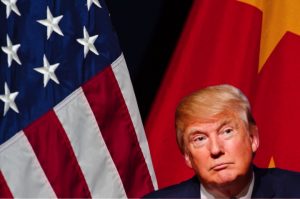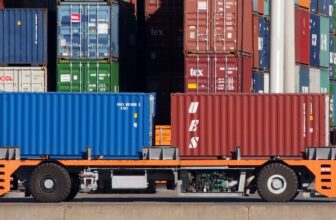
Though it seemed overshadowed in media coverage by shiny Nancy Pelosi pens, last week was a big news week for international trade. On Wednesday, January 15th, President Trump and China’s chief trade negotiator, Vice-Premier Liu He signed the Phase One Trade Agreement. Then on Thursday, January 16th, the Senate passed the United States-Mexico-Canada Agreement (USMCA).
From this post’s title, you know we’re going to really get into one of those trade deals, but first a quick recap of the run-up to these signings.
Both the Phase One Trade Agreement with China and the USMCA are a long time coming.
The U.S. and China have been in a trade war for the last year and a half with escalating tariffs and trade deal negotiations that lingered on and on, usually with little clarity about actual progress being made. In October, a breakthrough came with the announcement that the deal would be broken up into phases and the first phase agreement was reached in principle.
Negotiations for the USMCA began in 2017. President Trump, Mexican President Enrique Peña Nieto, and Canadian Prime Minister Justin Trudeau signed the trade deal back in 2018. President Trump and his administration urged the Senate to ratify the agreement ever since.
Previous Universal Cargo (UC) blog posts can give you more information about USMCA. A guest post from Alexandra Reay shared 4 ways USMCA could benefit your business. Another UC post dug deep into a speech by Vice President Pence, trying to get insight into how trade negotiations with China were going but really highlighting USMCA in the process.
Today’s blog starts a deep dive into the Phase One Trade Agreement with China. Now that it’s here, everyone has questions. What’s in the deal? All deals include give and take, so what concessions did the U.S. make? What concessions did China make?
I wanted to know myself and was tired of reading conflicting articles either bashing or praising the deal depending on the political bias of the news source, so I read the deal myself and set out to share what I see in it on a chapter by chapter (as the deal is broken into chapters) basis.
This undertaking turned out to be much more time consuming than I anticipated, so this blog will be broken into at least two phases, to be continued in Thursday’s post. Today’s post will cover the first four chapters.
What To Expect from This Look at the Phase One Trade Deal

Picture of Donald Trump by Michael Vadon. U.S. & Chinese flags added.
What this post is not is a breakdown of all the little details within the deal. Instead, I will go through each chapter and share overall impressions, highlighting some things that seem like a big deal to me. If, by chance, a chapter seems too general to be anything more than symbolic or just for show, I’ll share that.
The Office of the United States Trade Representative (USTR) published the newly signed Phase One Trade Agreement with China, titled within the document as Economic and Trade Agreement Between the Government of the United States of America and the Government of the People’s Republic of China. That is my source for the information found in this article, but there are a couple concessions the U.S. made outside of the deal itself that will also be included eventually in these posts.
Here are my impressions from Chapters 1-4 of the Phase One Trade Agreement:
Chapter 1 — Intellectual Property
China made concessions in the deal pertaining to intellectual property. In fact, Chapter 1 of the deal is entitled Intellectual Property.
The chapter states that both countries “shall ensure fair, adequate, and effective protection and enforcement of intellectual property rights” and “ensure fair and equitable market access to persons of the other Party that rely upon intellectual property protection.”
The chapter has 11 sections containing 36 articles getting into how intellectual property (IP) shall be protected. However, article after article in section after section of the chapter, it is stated, “The United States affirms that existing U.S. measures afford treatment equivalent to that provided for in this Article.”
In other words, this section is more about China changing its unfair trade practices than anything else.
That does not mean, however, there is nothing that the U.S. agrees to in this section that isn’t equivalent to already-existent U.S. measures. For example, the U.S. agrees, along with China, “to strengthen enforcement cooperation with a view to reducing the amount of counterfeit and pirated goods, including those that are exported or in transit.”
Actually, the agreement was for the countries to “endeavor” to do so. Therefore, even here, there is no specific ways in which the U.S. is to strengthen such cooperation while there is a whole paragraph in this section on how China will strengthen border enforcement with things like increasing the “number of trained personnel to inspect, detain, seize, effect administrative forfeiture, and otherwise execute customs’ enforcement…” There are even time frames in place for how quickly China puts these new anti-counterfeit measures into practice.
From reading the chapter, what is laid out are guidelines for a series of laws China is required to create and enforce to protect trade secrets, patents, pharmaceutical-related IP, e-commerce platforms, trademarks, and software from individuals, groups or organizations, and even government or government officials.
The agreement gives China 30 working days to “promulgate an Action Plan to strengthen intellectual property protection aimed at promoting its high-quality growth. This Action Plan shall include, but not be limited to, measures that China will take to implement its obligations under this Chapter and the date by which each measure will go into effect.”
It’s obvious Trade Representative Robert Lighthizer and the rest of the Trump Administration’s team held IP as an utmost concern when negotiating this deal.
Chapter 2 — Technology Transfer
A complaint U.S. companies have had against China for years is forced technology transfers when trying to enter their goods into Chinese markets. This goes hand in hand with IP protection, but the second chapter of the Phase One Trade Agreement is focused purely on technology transfer.
This chapter of the deal is much shorter than the first. It protects individuals and businesses from being forced or pressured to transfer their technology to Chinese persons or businesses in order to have access to Chinese markets.
The language actually goes for both China and the U.S.; however, this obviously addresses a problem specific to access to Chinese markets.
The chapter also means that businesses or individuals are not to be pressured to use technologies owned by Chinese entities or individuals in order to access Chinese markets. This helps level the playing field for U.S. companies in the Chinese market, creating more opportunity for them.
Additionally, this chapter requires transparency and due process in licensing, administrative processes, and law enforcement.
Again, these are parameters that China is being required to work within and a series of laws and enforcement will need to be created.
Chapter 3 — Remove Agricultural Bans
Chapter three of the deal is another long one. It deals with agricultural cooperation and gets into a lot of specifics. As is the case with previous chapters, this one is much more about China doing something the U.S. wants, namely, allowing the import of various U.S. agricultural goods, than the U.S. doing something China wants.
However, this section does have more U.S. requirements to it than previous ones, but that’s because it is dealing with goods that can spread sickness and therefore need to be controlled more tightly.
The chapter gets into dairy products, baby formula, poultry, beef, pork, processed meat, aquatic products, rice, grains, pet food, animal feed, and more.
While there are plenty of provisions for examination of agricultural goods to make sure they are safe, in this chapter, China agrees to remove bans placed on many U.S. agricultural goods, including poultry, cattle, and pet food, and streamlines the process for making U.S. agricultural goods eligible for export to China.
This should open the Chinese market much wider for U.S. agricultural exporters and will likely pay great dividends down the road.
Chapter 4 — Financial Services & Majority Stakes
Financial services, dealt with in Chapter 4, is another big area of non-discriminatory market access that China is agreeing to.
In this section, China agrees to allow American companies to provide banking, credit rating, electronic payment, financial asset management, insurance, securities, fund management, futures, and related services in China.
While this section applies to more than these, three American companies are listed by name in this section: Mastercard, Visa, and American Express.
One point that stands out to me is in Article 4.7:
“China affirms that existing U.S.-invested securities joint ventures are allowed to retain their existing licenses when they become U.S.-controlled, U.S. majority-owned, or wholly U.S.- owned securities companies.”
Previously, China blocked American companies from being able to acquire majority stakes in a joint venture with a Chinese company in China. In my mind, this is an important bit of freedom and opportunity for American companies in China.
Overview So Far…
Four chapters in and I’m mainly seeing concessions from China. These are mainly deal points the U.S. was looking for in a trade deal with China. We’ll see if that continues in Chapter 5 and beyond as I continue this on Thursday.
Click here to read Part 2, diving into chapters 5 and 6 of the Phase One Trade Agreement with China.
Discover more from reviewer4you.com
Subscribe to get the latest posts to your email.






